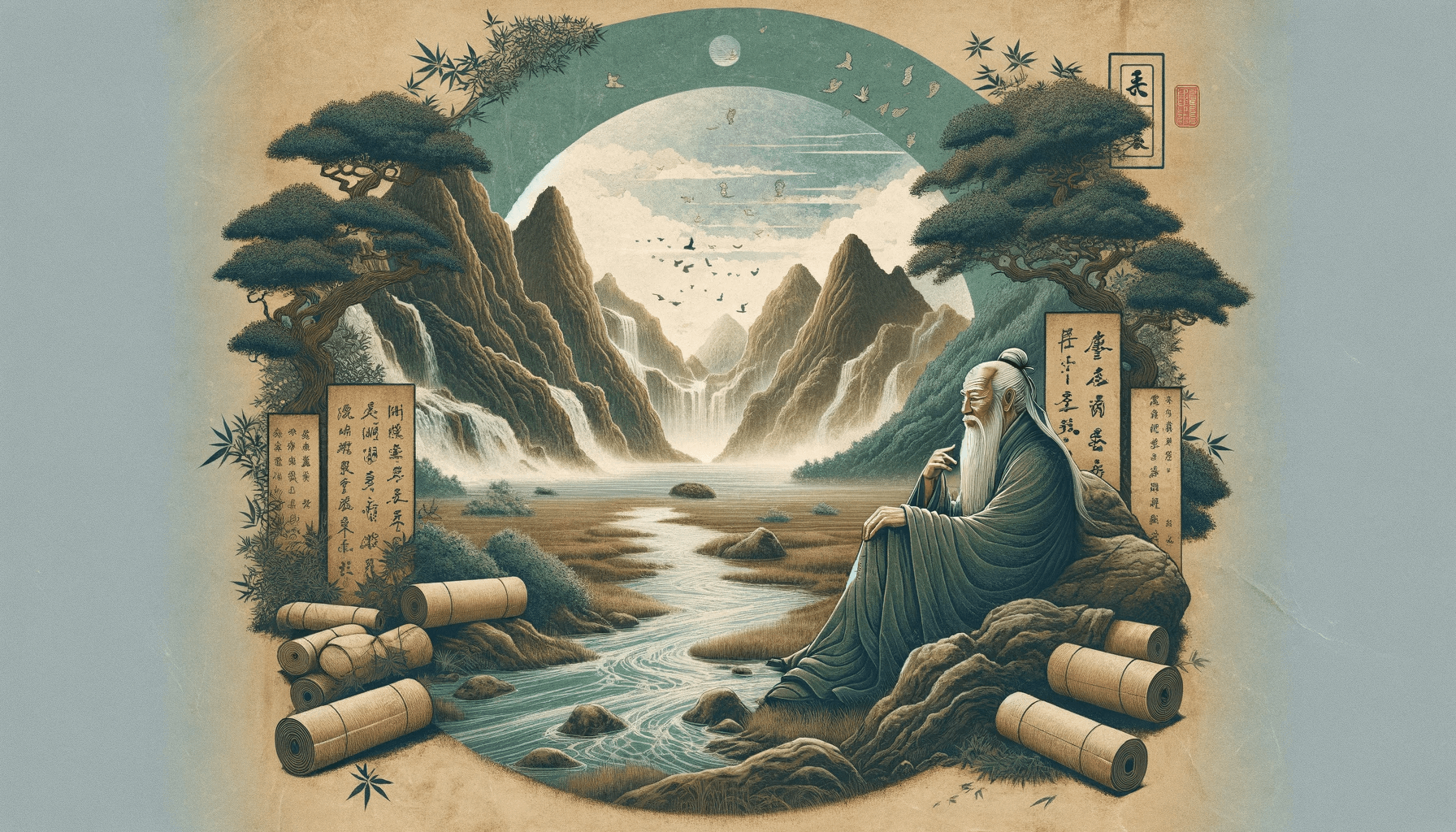Sponsor Awaken Your Great Self
Table of Contents
Introduction to Tao Te Ching
Tao Te Ching, one of the most profound and influential books ever written, offers timeless wisdom and teachings that continue to resonate with readers across the globe. Authored by the legendary Chinese philosopher Lao Tzu, this ancient text delves into the nature of existence, the principles of harmony, and the path to fulfillment. In this article, we will embark on a journey to explore the essence of Tao Te Ching and unravel the profound teachings of Lao Tzu.
The Life of Lao Tzu
Before delving into the teachings of Tao Te Ching, it is essential to understand the life of the enigmatic figure behind this remarkable text – Lao Tzu. Though surrounded by legends and myths, Lao Tzu is believed to have been a contemporary of Confucius, living in ancient China during the 6th century BCE. He was a sage and a keeper of knowledge, serving as the guardian of the imperial library. However, disillusioned by the corruption and chaos of society, Lao Tzu decided to withdraw from the world and seek a deeper understanding of existence.
Understanding the Principles of Tao Te Ching
The heart of Tao Te Ching lies in its principles, which serve as a guide to living a balanced and harmonious life. At its core, Tao Te Ching emphasizes the concept of Tao, often translated as “The Way.” Tao is the underlying principle of the universe, the source of all existence, and the ultimate reality. According to Lao Tzu, aligning oneself with the flow of Tao is the key to living in harmony with the natural order of things.
The Main Themes of Tao Te Ching
Tao Te Ching touches upon many themes, each offering valuable insights into the human experience. One of the central themes is the concept of simplicity. Lao Tzu suggests that one can attain true contentment by embracing simplicity and letting go of desires and attachments. Another prominent theme is the notion of non-action or Wu Wei. Contrary to the Western idea of striving for constant action, Lao Tzu emphasizes the power of effortless action, where one acts by the natural flow of things.
Exploring the Concept of Tao (The Way)
Exploring the concept of Tao (道, pronounced “Dào”) in Taoism, mainly as presented in the “Tao Te Ching,” is an exploration of one of the most profound and central ideas in Chinese philosophy. The Tao can be considered in various dimensions:
- The Ultimate Reality: In Taoism, the Tao is often described as the ultimate, indescribable principle underlying the universe. It’s the source of everything, yet it is ungraspable and beyond all forms and names.
- The Way of Nature: The Tao is also seen as the natural order of things, the universe’s operations. It’s the rhythm and pattern that everything in nature follows. This aspect of the Tao emphasizes living in harmony with the natural world, understanding its flow, and aligning one’s actions with this natural flow.
- The Path of Life: On a personal level, the Tao represents the path or way of life that one should follow. This path is not predefined or rigid but is discovered through a deep understanding of oneself and the nature of reality. It’s about finding balance, inner peace, and living by simplicity, humility, and non-action (wu-wei).
- A Guide for Governance: In a socio-political context, the Tao suggests a way of governance and leadership. The ideal ruler or leader, as per Taoist philosophy, governs in a way that is in harmony with the Tao, often characterized by minimal intervention, simplicity, and leading by example.
- Non-Duality and Unity: The Tao encompasses the concept of non-duality. It suggests that apparent opposites are interconnected and interdependent aspects of the whole. Understanding the Tao involves seeing beyond surface differences to the unity that lies beneath.
- Mystery and Intuition: The Tao is also associated with the mysterious and the intuitive. In the “Tao Te Ching,” Laozi states that the Tao that can be spoken of is not the eternal Tao, implying that the true nature of Tao lies beyond words and rational understanding. It’s something to be experienced or intuited rather than intellectually dissected.
- Influence on Arts and Culture: Tao has significantly influenced Chinese art, poetry, martial arts, and medicine, where the principles of naturalness, balance, and flow are predominant.
Understanding the Tao is about embracing a way of life that is in harmony with the fundamental principles of the universe. It is a personal and spiritual development journey requiring reflection, meditation, and a deep connection with the natural world.
Yin and Yang in Tao Te Ching
A fundamental concept in Tao Te Ching is the interplay between Yin and Yang. Yin represents the feminine, passive, and receptive aspects, while Yang symbolizes the masculine, active, and assertive qualities. Understanding Yin and Yang in the context of the “Tao Te Ching” involves exploring several key ideas:
- Dual but Complementary Forces: Yin and Yang symbolize opposing but complementary forces or principles found in all things. Yin is often associated with qualities such as passivity, darkness, cold, femininity, and receptiveness, while Yang is associated with activity, brightness, warmth, masculinity, and assertiveness.
- Interdependence: Yin and Yang are not static or absolute but relative. Each exists only about the other. This means nothing is purely Yin or Yang but a balance or a mixture of both.
- Dynamic Balance: One of Yin and Yang’s key aspects is balance and harmony. The “Tao Te Ching” emphasizes the importance of balancing these forces. When Yin and Yang are in balance, there is harmony, health, and order; when they are out of balance, there is disharmony, disease, and chaos.
- Constant Change and Transformation: Yin and Yang are also about transformation and the constant change inherent in the universe. Each contains the seed of the other, and they continuously transform into each other. For instance, day turns into night (Yang turns Yin), and winter turns into summer (Yin turns Yang).
- Manifestation in Nature and Human Life: In the “Tao Te Ching,” the interplay of Yin and Yang is seen as the fundamental way nature operates. This concept is also applied to human life, where maintaining a balance between Yin and Yang is essential to well-being.
- Practical Applications: In Taoism, understanding and working with the principles of Yin and Yang is practical. It’s applied in various disciplines like Traditional Chinese Medicine, Feng Shui, martial arts, and meditation, where the balance of energies is considered crucial for effectiveness and harmony.
- Philosophical Symbolism: The Yin-Yang symbol (Taijitu) visually represents this philosophy. The black and white swirls with a dot of the opposite color suggest the interplay and interconnectedness of the forces and the idea that each contains the essence of the other within it.
Yin and Yang in the “Tao Te Ching” represent a profound and nuanced understanding of the dualities and harmonies in the natural world and human existence. They symbolize the belief that a balanced and dynamic interplay of opposites is at the heart of the Tao, the underlying principle of the universe.
The Art of Wu Wei (Effortless Action)
The art of Wu Wei, often translated as “effortless action” or “non-action,” is a central concept in Taoist philosophy, particularly highlighted in the “Tao Te Ching.” Understanding Wu Wei involves delving into several nuanced aspects:
- Natural Action: Wu Wei does not mean inaction or laziness. Instead, it refers to taking action that is in harmony with the natural flow of the universe. It’s about acting in a natural and unforced way, like water flowing smoothly along a riverbed.
- Effortless Effort: Wu Wei involves doing what is necessary but no more. It’s about finding the most efficient, spontaneous, and uncontrived way of acting. The action under Wu Wei is often described as being so well-aligned with the natural order that it seems effortless.
- Spontaneity and Intuition: Actions in Wu Wei arise from a deep understanding and alignment with the natural world, often requiring intuition and spontaneity rather than rigid planning or forceful effort. It’s about responding to situations as they arise with a sense of ease and naturalness.
- Letting Go of Control: Wu Wei involves relinquishing excessive control and allowing things to unfold in their way. It is about understanding when to act and when not to act. It often means letting go of forced efforts and trusting the process.
- Alignment with the Tao: Practicing Wu Wei means aligning oneself with the Tao, the fundamental principle in Taoism. It’s about understanding and moving with the underlying essence of life and existence rather than struggling against it.
- Mindfulness and Awareness: To practice Wu Wei, one must cultivate a deep awareness of oneself and one’s environment. This heightened mindfulness allows for actions that are attuned to the dynamics of a situation.
- Application in Daily Life: In practical terms, Wu Wei can be applied in everyday life by choosing to act in ways that are in harmony with one’s true nature, societal norms, and the environment. It encourages a balanced approach to challenges, often leading to solutions that feel natural and unforced.
- Ethical and Moral Implications: Wu Wei also has ethical dimensions, suggesting that the best actions arise from a moral and harmonious inner state. It implies that when one is in tune with the Tao, one’s actions will naturally be ethical and beneficial to both oneself and others.
In essence, Wu Wei is an art of living that advocates for actions that are in harmony with the natural rhythms of the universe, actions that are effortless yet effective, and that emanate from a place of balance and wisdom. It’s a principle that encourages flowing with life’s currents rather than swimming against them, leading to a life of less stress and greater harmony.
Applying the Teachings of Tao Te Ching in Daily Life
Applying the teachings of the “Tao Te Ching” in daily life can provide a framework for living with greater harmony, simplicity, and mindfulness. Here are some practical ways to integrate its teachings:
- Embrace Simplicity: The “Tao Te Ching” advocates for a simple and uncluttered life. This can mean reducing physical possessions, simplifying your schedule, and focusing on what’s truly important. It’s about finding contentment in the simple pleasures of life.
- Practice Wu Wei (Effortless Action): This involves taking actions aligned with the natural flow of life. It means not forcing things but responding to life’s events with ease and spontaneity. Practically, it’s about doing what feels natural and right in any situation rather than overthinking or overexerting.
- Cultivate Flexibility and Resilience: Inspired by the Taoist appreciation of water, aim to be adaptable and resilient in the face of change. Be open to new ideas, willing to change course when necessary, and able to bounce back from setbacks.
- Seek Harmony and Balance: Balance your personal, professional, and social life. Pay attention to the Yin (receptive, passive, inward) and Yang (active, dynamic, outward) aspects of life. Strive for a healthy balance in work, rest, relationships, and personal interests.
- Develop Mindfulness and Presence: Practice being present in the moment. This can involve mindfulness techniques, meditation, or simply paying full attention to whatever you’re doing, whether eating, walking, or talking with someone.
- Cultivate Compassion and Empathy: The “Tao Te Ching” emphasizes the virtues of compassion and kindness. In daily interactions, practice understanding and empathizing with others. This can improve relationships and foster a sense of connectedness.
- Let Go of Excessive Desire and Control: Avoid wanting more or trying to control everything. Learn to be content with what you have and accept that some things are beyond your control.
- Lead by Example: If you are in a position of leadership or influence, lead with humility and by example rather than through force or authority. Encourage others by your actions and character.
- Reflect Regularly: Spend time in reflection or meditation, contemplating the nature of your life and your place in the world. This can help in aligning your actions with your deeper values.
- Harmonize with Nature: Spend time in nature and observe its patterns. This can provide insights into the natural flow of things and how you might align your life with this flow.
Incorporating the wisdom of the “Tao Te Ching” into daily life can lead to a more peaceful, balanced, and fulfilling existence. It’s about finding a path harmonious with the natural world and your true nature.
Interpretations of Tao Te Ching
Over the centuries, Tao Te Ching has been subject to countless interpretations and translations. Each interpretation offers a unique lens through which we can explore the deep wisdom contained within the text. Scholars, philosophers, and spiritual seekers have all sought to unravel the profound teachings of Lao Tzu, adapting them to different cultural contexts and personal understandings. The beauty of Tao Te Ching lies in its ability to transcend time and space, resonating with individuals from various backgrounds and belief systems.
Conclusion: The Enduring Wisdom of Lao Tzu’s Tao Te Ching
In conclusion, Tao Te Ching is a timeless masterpiece that continues to inspire and guide individuals on their quest for a meaningful life. Lao Tzu’s teachings offer a profound understanding of the nature of existence, the principles of harmony, and the path to living in alignment with the flow of Tao. By embracing the wisdom of Tao Te Ching, we can cultivate inner peace, foster harmonious relationships, and navigate life’s challenges with grace and ease. Let us embark on this transformative journey, unraveling the teachings of Lao Tzu and rediscovering the essence of Tao Te Ching.
CTA: If you seek a deeper understanding of life and a path to inner harmony, I invite you to explore the profound teachings of Tao Te Ching. Embrace the wisdom of Lao Tzu and discover the transformative power of living in alignment with the flow of Tao.




